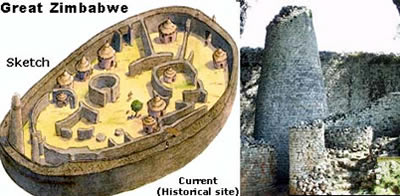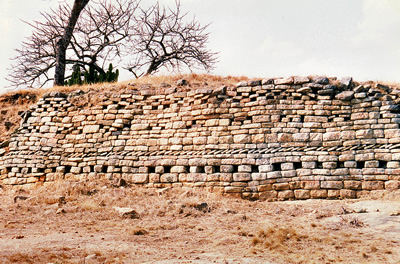World History
As with much of southern Africa, the earliest inhabitants of what is now the country of Zimbabwe were the nomadic San peoples, who led a life in search of game and edible vegetation about 20,000 years ago.
Later the Khoi-Khoi people, pastoralists with herds, entered the region. The two cultures fused into the Khoisan people, who have shown an amazing degree of adaptation to one of the world’s most forbidding climates: the Kalahari Desert.
By approximately 500 the Bantu arrived as the Gokomere people, climaxing the long Bantu migration from the central Sahara, which was most likely caused by the country’s turning into desert and driving out the livestock-herding Bantus. Whether this was the cause of overgrazing or an early example of global climate change is unclear.
The settlements at Mapungubwe in the Limpopo River valley date from the 10th century, although archaeologists have found evidence from as remote as the third century. By 1175 Mapungubwe had become the center of a small kingdom whose population was devoted to raising livestock.
Gold, however, is what drew Arab traders originally to the region. The region became involved in trade throughout the world, as John Reader notes in Africa: A Biography of the Continent, “glass beads made in India and Egypt testify to the community’s involvement in long-distance trade.â€
Sometime during this era of Bantu migration to the region, the great stone, cyclopean structures of Zimbabwe, Khami, and Dhlo-Dhlo were built, the Stonehenges of southern Africa. It was buildings like these, and the legends that grew up around them, that led Victorian author H. Rider Haggard to write his classic adventure novels She, King Solomon’s Mines, and Allan Quartermain.
John Reader writes, “At the time of its pre-eminence in the fifteenth century, at least 11,000 and as many as 18,000 people are said to have lived at Great Zimbabwe.†Reader notes that Zimbabwe was built between 1275 and 1550.
By the 14th century the Bantus had created the Mutapa empire, which would reach to the East African coast at Mozambique. Even before this, Arab merchants were in large numbers in the coastal cities, creating an oceanic trade with what are now Saudi Arabia, Yemen, and east to India in their sailing ships, or dhows. Their voyages would be expertly timed with the monsoon seasons, which still dominate the region today.
By the 16th century the Portuguese, with their far more heavily armed caravels, dominated the trade on both coasts of Africa, building castles to protect their trading interests from the African chiefs and Arabs with whom they were in competition. In 1498 Vasco da Gama reached India, thus making Portugal the first of the European maritime trading empires.
On his voyage down the West African coast, he had seen Arab dhows picking up the vast amount of gold that the Mutapa empire and the Shonas sent to the coast, a product of the rich gold mining that was the greatest heritage of old Zimbabwe.
- East African City-states
East African City-states The Bantu migration from the central Sahara, perhaps the defining event in the history of Africa south of the Sahara, brought people to the region of East Africa as the nucleus of the emerging city-states. From the 10th century,...
- Omani Empire In East Africa
Ruin of Omani Empire Palace The Omani empire in East Africa was based on the Swahili coast, which extended from present-day central Somalia to Cape Delgado in southern Mozambique. It included a number of islands and archipelagos in the Indian Ocean. There...
- History Of Mozambique
History of Mozambique. This is a brief essay on the history of the African nation of Mozambique. As with most essays from the History of Nations site, the emphasis is on 20th century political history. The Encyclopædia Britannica notes, "Officially Republic...
- History Of South Africa
History of South Africa. This is an essay which covers the history of the nation of South Africa. Needless to say, South Africa has had an interesting history including Shaka and the Zulus, the Boers, apartheid, and high crime rates. Wikipedia notes,...
- Great Zimbabwe
Great Zimbabwe. Description of the lost civilization of Great Zimbabwe, east of the Kalahari Desert, between the Zambezi and Limpopo Rivers. From the site: Not much is known about the people and the culture of Great Zimbabwe. This is due to the fact that...
World History
Zimbabwe
 |
| Zimbabwe |
As with much of southern Africa, the earliest inhabitants of what is now the country of Zimbabwe were the nomadic San peoples, who led a life in search of game and edible vegetation about 20,000 years ago.
Later the Khoi-Khoi people, pastoralists with herds, entered the region. The two cultures fused into the Khoisan people, who have shown an amazing degree of adaptation to one of the world’s most forbidding climates: the Kalahari Desert.
By approximately 500 the Bantu arrived as the Gokomere people, climaxing the long Bantu migration from the central Sahara, which was most likely caused by the country’s turning into desert and driving out the livestock-herding Bantus. Whether this was the cause of overgrazing or an early example of global climate change is unclear.
  |   |
The settlements at Mapungubwe in the Limpopo River valley date from the 10th century, although archaeologists have found evidence from as remote as the third century. By 1175 Mapungubwe had become the center of a small kingdom whose population was devoted to raising livestock.
Gold, however, is what drew Arab traders originally to the region. The region became involved in trade throughout the world, as John Reader notes in Africa: A Biography of the Continent, “glass beads made in India and Egypt testify to the community’s involvement in long-distance trade.â€
Sometime during this era of Bantu migration to the region, the great stone, cyclopean structures of Zimbabwe, Khami, and Dhlo-Dhlo were built, the Stonehenges of southern Africa. It was buildings like these, and the legends that grew up around them, that led Victorian author H. Rider Haggard to write his classic adventure novels She, King Solomon’s Mines, and Allan Quartermain.
 |
| Ruin of Dhlo-Dhlo |
John Reader writes, “At the time of its pre-eminence in the fifteenth century, at least 11,000 and as many as 18,000 people are said to have lived at Great Zimbabwe.†Reader notes that Zimbabwe was built between 1275 and 1550.
By the 14th century the Bantus had created the Mutapa empire, which would reach to the East African coast at Mozambique. Even before this, Arab merchants were in large numbers in the coastal cities, creating an oceanic trade with what are now Saudi Arabia, Yemen, and east to India in their sailing ships, or dhows. Their voyages would be expertly timed with the monsoon seasons, which still dominate the region today.
By the 16th century the Portuguese, with their far more heavily armed caravels, dominated the trade on both coasts of Africa, building castles to protect their trading interests from the African chiefs and Arabs with whom they were in competition. In 1498 Vasco da Gama reached India, thus making Portugal the first of the European maritime trading empires.
On his voyage down the West African coast, he had seen Arab dhows picking up the vast amount of gold that the Mutapa empire and the Shonas sent to the coast, a product of the rich gold mining that was the greatest heritage of old Zimbabwe.
- East African City-states
East African City-states The Bantu migration from the central Sahara, perhaps the defining event in the history of Africa south of the Sahara, brought people to the region of East Africa as the nucleus of the emerging city-states. From the 10th century,...
- Omani Empire In East Africa
Ruin of Omani Empire Palace The Omani empire in East Africa was based on the Swahili coast, which extended from present-day central Somalia to Cape Delgado in southern Mozambique. It included a number of islands and archipelagos in the Indian Ocean. There...
- History Of Mozambique
History of Mozambique. This is a brief essay on the history of the African nation of Mozambique. As with most essays from the History of Nations site, the emphasis is on 20th century political history. The Encyclopædia Britannica notes, "Officially Republic...
- History Of South Africa
History of South Africa. This is an essay which covers the history of the nation of South Africa. Needless to say, South Africa has had an interesting history including Shaka and the Zulus, the Boers, apartheid, and high crime rates. Wikipedia notes,...
- Great Zimbabwe
Great Zimbabwe. Description of the lost civilization of Great Zimbabwe, east of the Kalahari Desert, between the Zambezi and Limpopo Rivers. From the site: Not much is known about the people and the culture of Great Zimbabwe. This is due to the fact that...
